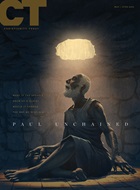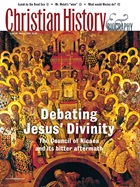In Dorothy Sayers's imaginative play, The Emperor Constantine, the defining role of the Nicene creed is put into words when Constantine criticizes a group of bishops for their indecisiveness: "Our Lord said to the Samaritan woman, 'You worship what you know not, but we know whom we worship.' Do you know whom you worship? It would seem you do not. And it matters now that you should." The question, "Do you know whom you worship?" has been a perennial one for Christians, but it came to the forefront at the beginning of the fourth century when there was as yet no doctrinal consensus about the divinity of Christ.
All Christians asserted that Jesus was God and worshipped Him as such, following the understanding laid down in an early second-century sermon known as II Clement: "brethren, we ought to think of Jesus as we do of God." However, those baptismal creeds which have come down to us from local churches said very little beyond the basic wording: "of Jesus Christ as the Son of God, who was born of the Holy Spirit and the Virgin Mary" (Apostolic Tradition of Hippolytus).
Such confessional statements left many questions unanswered. How could the Son, who was born a human being, suffered and died, also be God in relation to God the Father? Which Bible passages were speaking about the Son's divinity and which were about the Son's humanity? When Jesus declared his dread of the "cup" before him (Matt. 26:37-38), or displayed ignorance about the time of his second return (Mk. 13:32), surely these experiences were applicable to his human self, but what did that mean for his divinity? If Christ suffered on our behalf did that mean he was different from God who, by virtue of his immutability and eternality, cannot suffer? There was no agreement among Christians about the Bible's teaching on these issues.
It was inevitable, therefore, that the early church would eventually require a more universal statement of faith like the Nicene Creed. As the church grew in numbers, geographical distance and theological sophistication, the need for a comprehensive explanation of the Christian faith grew as well. The interchurch crisis between Arius and Alexander erupted and spread throughout the East so quickly precisely because Christian teaching was unsettled on these matters. As this crisis took hold of churches in Egypt, Palestine, Asia Minor and even Greece, local baptismal confessions were obviously insufficient to address the widespread nature of the conflict. While these confessions would continue to be regarded as authoritative throughout the fourth century, their wording was not exact enough to insure future doctrinal orthodoxy.
This is what later prompted Augustine (in On Faith and the Creed) to use the Nicene faith as the lens for interpreting the older church creed of North Africa. When the believer professed, "I believe … in Jesus Christ, the Son of God, only-begotten of the Father, our Lord, who was born through the Holy Spirit of the Virgin Mary," there was no dispute about its truth, but "under color of the few words found in the [North African] creed, many heretics have attempted to conceal their poison."
It was just a matter of time, therefore, that a formal statement about the identity of Christ in relation to the Father should be debated and endorsed by an official body. Not only would error have to be ruled out, but it first had to be redefined, as would the parameters for a proper scriptural interpretation of God as Father, Son and Holy Spirit.
Out of the heart of the church
At the end of the 19th and early 20th centuries, some Protestant historians regarded the Council of Nicaea and its creed with the same suspicion as they did the church of Rome. The esteemed German scholar Eduard Schwarz, for example, depicted the conflicts between pro-Nicene and "Arian" opponents as in reality a struggle for power within the church which was disguised as a theological dispute. The council's decisions represented a victory for those who wielded the most influence over the emperor. This meant too that the creed was an unfortunate capitulation of the church to imperial politics and an emblem of the new merger between the Roman empire and Christianity.
To this day, some churches and denominations see creeds, ancient or modern, as little more than legislated statements of power used for manipulating the faithful. Such a view is often built on the assumption that the church by the time of Nicaea had compromised its original biblical standards, replacing principles of Scripture with the authoritarianism of a new imperial and episcopal establishment.
While the council did involve interchurch politics with dissenting groups trying to obtain the emperor's ear, the Nicene Creed had its origin in the worshipping life of the church. A mere collective of bishops could not make for sound Christian doctrine. We are mistaken to cast the early bishops into the role of power brokers and political schemers, rather than the pastors and preachers that most of them were. Interpreting and proclaiming the true faith to their congregations was a major preoccupation with nearly every one of the early church theologians.
Likewise, creedal statements had to represent the common mind of the church or else they would not have been accepted and employed by the larger body of believing Christians. The vigilance of bishops in upholding and preserving Christian truth is exemplified in the opening words of the Council of Antioch (which met in the early months of 325) when it declared that its statement of faith was "the faith that was set forth by spiritual men … always formed and trained in the spirit by means of the holy writings of the inspired books." At the councils at Antioch and Nicaea, both of which formulated creeds, the concern was the same: articulating a theological vision that emerged from the church's faith. In effect, the creed was a statement ex corde ecclesiae—out of the heart of the church.
Rooted in tradition
However the members of the council derived the creed that they finally issued—and no minutes from the proceedings are ever cited by later church historians or have otherwise been discovered—local baptismal creeds were actively sought and used. After all, a creed was supposed to be exactly what the word meant: a confession of the faith by the people of God, thus reflecting what the churches were confessing.
While no exact parallels can be made, the Nicene formulation seems most closely related to the baptismal declarations used in the churches of Caesarea and Jerusalem. In a letter written his congregation just after the close of the Nicene council, Eusebius of Caesarea explained that though he was reluctant to sign the Nicene creed, he would never have done so had that formula contradicted the faith of the Caesarean church. After making every inquiry into the meaning of the creed's wording, Eusebius wrote, "it appeared to us to coincide with what we ourselves have professed in the faith which we have previously preached."
Scripturally Based
None of the preceding is meant to imply there were no immediate difficulties with the creed that the bishops at Nicaea produced. Many bishops were concerned that the creed failed to distinguish sufficiently the being of the Son from the Father. Describing the Son as "from the substance of the Father" or of "the same substance" (homoousios) as the Father made it seem as if the Father and Son were really identical, separated only by their names. Later known as "modalism," this was a heretical view that had been condemned in the previous century because it stressed the monotheist character of Christianity at the cost of upholding a substantial Trinitarianism. Suspicions were further aroused by the fact that two strong supporters of the Nicene creed, Eustathius of Antioch and Marcellus of Ancyra, were known advocates of a modalist type of view about God.
Moreover, these same words were not found anywhere in Scripture. Prior to and throughout the fourth century, all creedal terminology was drawn from the very words of the Bible. Not a few bishops in the East opposed the new creed in the years after 325 because it seemed to introduce unscriptural terms.
Nevertheless, proponents of Nicaea argued that the creed and its controversial terms were a theological extension of New Testament teaching about Christ. This is exactly the point Athanasius made in his On the Definition of the Nicene Creed, which he wrote in defense of the creed a quarter of a century after the council met. New theological language was necessary in order to meet the theological needs brought about by the recent challenges to the church's faith. Despite some of the terms used, Athanasius declared, the final creed was the natural outcome of the church's preaching, reflection, and biblical exegesis. Even if we allow for special pleading on Athanasius' part, we may safely assume that those bishops who signed the creed believed it was a fitting summary of biblical teaching.
The charge laid against Nicaea by later theologians that the creed was more the product of philosophical influence or "Hellenization" than of Scripture is misconstrued for two reasons. First, all Christian thinkers of the time—"orthodox" and "heretical"—were drawing on contemporary philosophical language in order to frame theological truths. Terms such as person, substance, essence, and many others all had a philosophical background that pre-dated Christianity but were borrowed permanently for Christian purposes. Where there was obvious conflict between the Bible and Greek philosophy, the Bible took precedent for even the most erudite Christians.
Second, one of the lessons learned during the "Arian controversy" was that in order to achieve doctrinal orthodoxy you cannot interpret the Bible from the Bible alone. The church needed a vocabulary and a conceptual framework that stemmed from the Bible but were also outside of the Bible. Sooner or later, some means of interpreting the scriptural text would be required.
Whatever else may be said of the ancient creeds, it cannot be denied that they were deliberately constructed to be the epitome of the biblical message. When instructing new converts, Augustine taught, "For whatever you hear in the Creed is contained in the inspired books of Holy Scripture" (Sermon 212. 2). It was the task of these creeds not merely to reproduce the Bible but to enable Christians to understand what the Bible, both Old and New Testament, means.
In the end, the Nicene Creed represented a large-scale attempt to answer the question, "Do you know whom you worship?" Christianity's central convictions that God is one and Christ is God had to be put into a cohesive statement that preserved the integrity of both. This was the burden of the fourth century. The Council of Nicaea responded with a creed that was new to church history and was not immediately accepted, but, as time would tell, it was crafted according to the intention of church tradition and biblical principles. As Charles Williams once said of the Christian faith encapsulated by the Nicene Creed, "It had become a Creed, and it remained a Gospel."
D.H. Williams is professor of patristics and historical theology at Baylor University and the author of Evangelicals and Tradition: The Formative Influence of the Early Church (Baker Academic, 2005) and The Free Church and the Early Church: Essays in Bridging the Historical and Theological Divide (Eerdmans, 2002).
Copyright © 2005 by the author or Christianity Today/Christian History & Biography magazine.
Click here for reprint information on Christian History & Biography.

Support Our Work
Subscribe to CT for less than $4.25/month






























